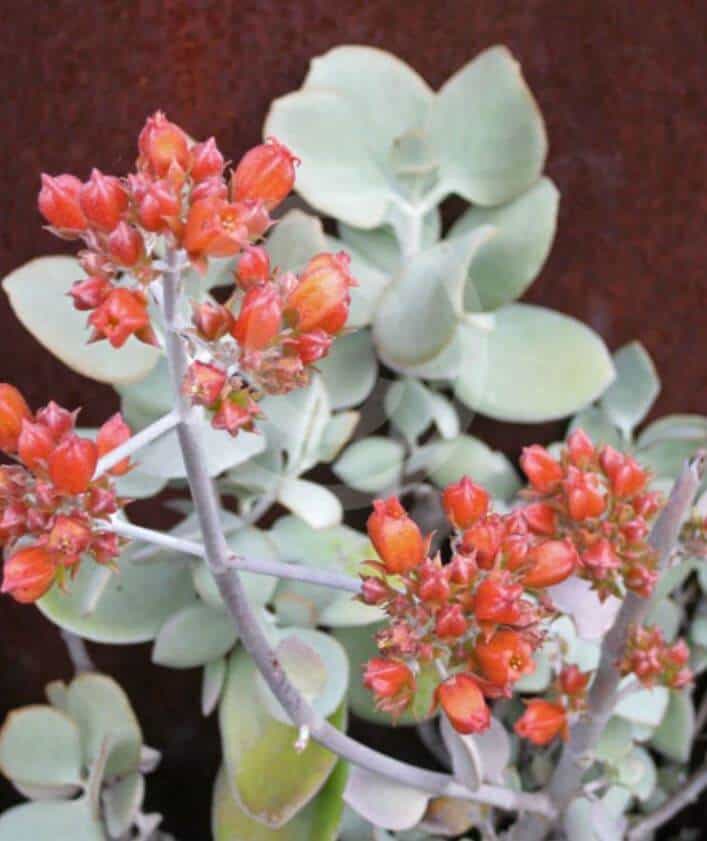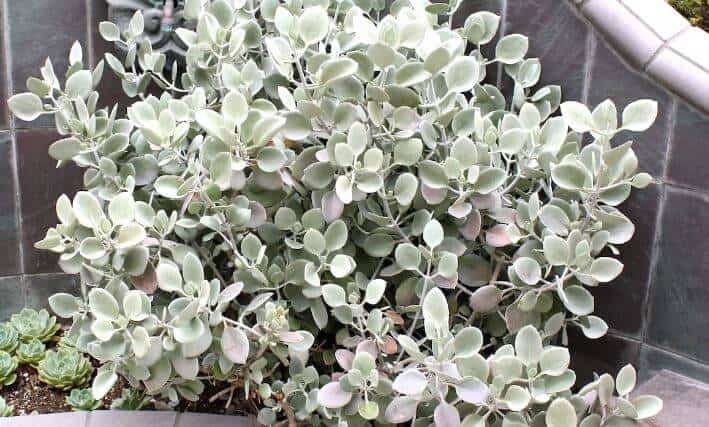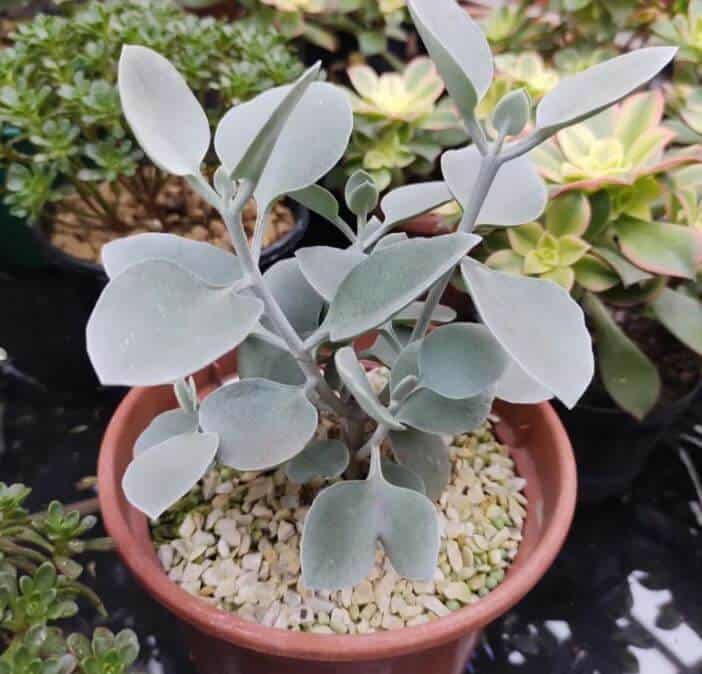Last Updated on January 5, 2023 by a Friendly Gardener
Delicate silver leaves with pointed tips characterize this gorgeous succulent native to southwest and central Madagascar. Known botanically as the Kalanchoe bracteate and a member of the Crassulaceae family, the Silver Teaspoons plant is a unique perennial that is not particularly challenging to cultivate.
Small and compact, this Kalanchoe variety can grow to three feet in height. Stems are woody and branch out in several directions. Soft foliage boats a silvery grayish hue and resembles a spoon shape, either obovate or circular, hence its popular name. Leaves can range in size from approximately a half inch to 1.5 inches in length. Leaves feature ciliate hairs that contribute to a velvety texture and are actually green, but the presence of flour on foliage creates its silvery appearance.
In its native habitat, it can be found growing in organically fertile soil between rocky formations in open woodlands, generally between 2300 and 4600 feet above sea level. A slow-growing plant, it will produce red blossoms generally in October and makes a beautiful addition to indoor home gardens.
Silver Teaspoons Plant Care

Silver Teaspoons plants do not require much care and are relatively easy to maintain when provided with ideal environmental conditions.
Soil
Succulents, and the Silver Teaspoons plant is no exception, require porous soil to ensure good drainage and airflow in the soil bed. When cultivating in a container, use a cactus or succulent potting soil mix for the best results. This type of soil mix prevents excess water from being retained and drowning your plant. Soggy, waterlogged soil will kill your plant as excess oxygen prevents air from reaching roots and root rot will set in.
For extra protection, you can add pumice, perlite, or coarse sand to your cactus soil mix. Soil should be moist but not wet. Should you decide to plant Silver Teaspoons outside in a garden soil bed, make sure it is well-draining.
Light

This is a plant that loves light both direct and indirect as long as it is generous. If sunlight is particularly harsh, it may scorch leaves, but the Silver Teaspoons prefer full sunlight exposure. So, for indoor cultivation place it in or near a window. In the winter, during dormancy, place your plant near a window where it will continue to receive bright indirect light.
Water
As a succulent, the Silver Teaspoons stores water in its foliage, meaning it will require less water than many other houseplants. Most diseases for the kalanchoe are provoked by overwatering such as fungal infections.
In the summer it will require more frequent watering. The soil type will aid in your managing water needs. If the soil mix offers excellent drainage, you’ll have a much better chance of avoiding overwatering.
To check moisture levels, use a moisture meter or dip your finger into the soil to ascertain whether the top two inches of the soil bed have dried out. If so, your Silver Teaspoons need a drink. If the plant’s lower leaves wilt or wrinkle, your plant is suffering from dehydration.
Succulent root systems tend to be shallow, so allow the soil bed to dry sufficiently before watering anew. Do not water from above to avoid wetting foliage. Water near the base of the plant.
Humidity
Silver Teaspoons plants adapt to just about any humidity level. Your home’s humidity level will determine how often you need to water your plant. Water less if levels are high, and more if they are in the lower range.
Temperature
This is a plant that does well in warm environments. Any climate that is extreme, regardless of whether hot or cold, will negatively affect this plant. Excessive cold can cause freezing or frost damage and lead to death. If cultivating outdoors and living in a colder climate, consider using a frost cloth to cover the Silver Teaspoons.
Feeding

In its native habitat in Madagascar, the soil is fertile, so when cultivating it at home, occasional feeding is recommended. Feed the plant monthly with an NPK 3-1-3 liquid fertilizer. During the growing season in spring when flower production begins, increase the NPK to 3-1-4 or 2-1-4 to improve the chances of continuous blooming.
Pruning

This succulent is not a plant that requires particular pruning. The principal reasons for pruning are a sick or dying branch and pest infestations. You will however want to trim away dead flowers and stalks to encourage more blooming. If you want a more compact plant, pinch off branches to stimulate further branching. This is also recommended for older plants as they may tend to become leggy and stimulate blooming.
Potting and Repotting

As a very slow-growing succulent, it can manage to remain in the same pot for several years without difficulty. It will however require the freshening of soil as it requires a more organically fertile soil bed than other succulents. Consider repotting annually or every other year to replace the soil.
Gently remove your plant shaking loose old soil from the root system and replant it in its container with new soil mix. If your plant seems glued to its container, run a gardening knife around the inside edge of the pot to loosen it before removing it.
Silver Teaspoons Propagation

Propagation is straightforward using either stem tip cuttings or leaves. Remove a cutting or leaf and set it to dry for a day to form a callus. Afterward, treat the cut end with root growth hormone. Plant the cutting or leaf in fresh soil. Water your cutting and be patient. In several weeks new roots should form.
Silver Teaspoons Plant Problems
These succulents are relatively resistant to common houseplant pests, but it can fall prey to spider mites, aphids, mealybugs, or scale. Removing dead foliage will aid in pest prevention as bugs like to hide in them. Humidity helps in fighting spider mites as they do best in dry conditions. The healthier the plant, the easier it will be to repel any undesirable visitors.
Should your plant show signs of infestation, isolate it from other houseplants or garden plants. Infested plants can be treated with organic Neem oil, garlic spray, hot pepper spray, or insecticidal soap. Start with a small portion of the plant when treating to check if the concentration used does not provoke a reverse reaction.
Yellowing foliage will indicate either a lack of nutrients or overwatering. If the soil bed feels soggy, it’s the water. Interrupt watering, drain excess water, and verify if root rot has set in. Otherwise, feed your plant to supply the necessary nutrients.
If root rot has set in, and you’ll know from the mushy smelly roots or stems, remove the plant from its pot and from the wet soil. Trim away any damaged roots. Repot your plant in fresh dry soil and wait at least a week to ten days before watering again.
Curling leaves can indicate overwatering or insufficient sunlight. Check for soil bed sogginess or reposition your plant to increase the amount of sunshine it receives.


